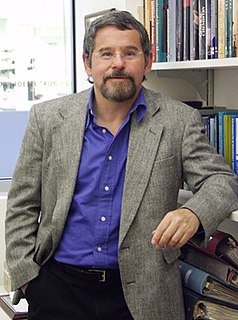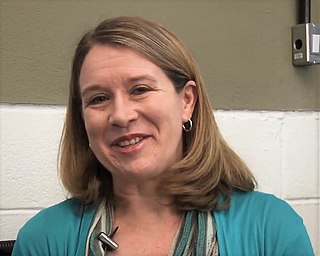Related Research Articles

Armand Paul Alivisatos is an American chemist who serves as the 14th president of the University of Chicago. Alivisatos is a scientist of Greek descent who has been hailed as a pioneer in nanomaterials development and is an internationally recognized authority on the fabrication of nanocrystals and their use in biomedical and renewable energy applications. He was ranked fifth among the world's top 100 chemists for the period 2000–2010 in the list released by Thomson Reuters. In February 2021, he was named the next president of the University of Chicago.

Richard Neil Zare is the Marguerite Blake Wilbur Professor in Natural Science and a Professor of Chemistry at Stanford University. Throughout his career, Zare has made a considerable impact in physical chemistry and analytical chemistry, particularly through the development of laser-induced fluorescence (LIF) and the study of chemical reactions at the molecular and nanoscale level. LIF is an extremely sensitive technique with applications ranging from analytical chemistry and molecular biology to astrophysics. One of its applications was the sequencing of the human genome.

Joseph Wang is an American researcher and inventor. He is Distinguished Professor, SAIC Endowed Chair, and former Chair of the Department of Nanoengineering at the University of California, San Diego specializing in nanomachines, biosensors, nanobioelectronics, wearable devices, and electrochemistry. He also serves as the Director of the Center for Wearable Sensors at the University of California San Diego Jacobs School of Engineering.

Allen Joseph Bard is an American chemist. He is the Hackerman-Welch Regents Chair Professor and director of the Center for Electrochemistry at the University of Texas at Austin. Bard is considered a "father of modern electrochemistry" for his innovative work developing the scanning electrochemical microscope, his co-discovery of electrochemiluminescence, his key contributions to photoelectrochemistry of semiconductor electrodes, and co-authoring a seminal textbook.
Charles R. Martin is an American Distinguished Professor of chemistry at University of Florida. He is a Nanotechnology expert and a pioneer of membrane-based template synthesis of nanomaterials. He is listed as one of the World's Top 100 Chemists of the past decade (2000–2010) by Thompson Reuters. He is also a musician and songwriter in Gainesville, Florida.

Geraldine Lee Richmond is an American chemist and physical chemist who is serving as the Under Secretary of Energy for Science in the US Department of Energy. Richmond was confirmed to her DOE role by the United States Senate on November 5, 2021. Richmond is the Presidential Chair in Science and Professor of Chemistry at the University of Oregon (UO). She conducts fundamental research to understand the chemistry and physics of complex surfaces and interfaces. These understandings are most relevant to energy production, atmospheric chemistry and remediation of the environment. Throughout her career she has worked to increase the number and success of women scientists in the U.S. and in many developing countries in Africa, Asia and South America. Richmond has served as president of the American Association for the Advancement of Science, and she received the 2013 National Medal of Science.

'Jose H. Zagal Moya is a Chilean scientist educated at the University of Chile with postgraduate training in the United States of America with a Ph.D. degree from Case Western Reserve University, Cleveland Ohio and postdoctoral training at Brookhaven National Laboratory, Upton, New York. At present he is a Distinguished Professor, Department of Chemistry and Materials, Faculty of Chemistry and Biology, Universidad de Santiago de Chile (USACH) where he directs the Laboratory of Electrocatalysis since 1982. He got his Ph.D. in chemistry Case Western Reserve University, US (1978) and was postdoctoral fellow at Brookhaven National Laboratory, Upton, New York, in 1982. His main research efforts are focused on the fundamentals of electron transfer reactions that are relevant for energy conversion and sensors. He has contributed in the area of electrocatalysis, electrodes modified with metal macrocyclics, electrochemistry of biological molecules, the catalysis of the reduction of molecular oxygen and many other reactions of relevance, conductive polymers, electrochemical sensors and in pioneering work in the establishment of non-linear correlations between thermodynamic properties of molecular catalysts and their electrochemical reactivity. These contributions are essential in the development of non-precious metal catalysts for energy conversion devices and electrochemical sensors. [1][2][3] He also has contributed in the field of corrosion, conductive polymers and his well-known volcano correlations for the electrocatalytic properties of surface-confined molecular catalysts

Andrzej Wieckowski was an Emeritus Professor of Chemistry at the University of Illinois at Urbana–Champaign and the North American Editor of Electrochimica Acta. He is known for his spectroscopic investigations of electrocatalysis in fuel cells and co-inventing of the direct formic acid fuel cell (DFAFC). He authored more than 300 publications, has been cited over 13,000 times and has an h-index 60. He was appointed fellow of the Electrochemical Society in 2007 and fellow of the International Society of Electrochemistry in 2009. He was awarded the US Department of Energy Prize for outstanding Scientific Accomplishment in Materials Chemistry in 1992, the ISE Jacques Tacussel Prize in 1998, the ECS David. C. Graham Award in 2003, and the ISE Gold Medal in 2007.
Tebello Nyokong is a South African chemist and professor at Rhodes University, and a recipient of the Presidency of South Africa's Order of Mapungubwe in Bronze. She was awarded the South African Chemical Institute Gold Medal in 2012, and named one of the top 10 most influential women in science and technology in Africa by IT News Africa. She is currently researching photo-dynamic therapy, an alternative cancer treatment method to chemotherapy. In 2007, she was one of the top three publishing scientists in South Africa, and in 2013 she was awarded the National Research Foundation's Lifetime Achievement Award.

Foil Allan Miller was an American chemist and philatelist best known for his work in infrared and Raman spectroscopy. He was head of the spectroscopy division of the Mellon Institute and later professor and head of the spectroscopy laboratory at the University of Pittsburgh. Among other publications, he co-authored the books Course Notes on the Interpretation of Infrared and Raman Spectra (2004) and A Philatelic Ramble Through Chemistry (1998).
Cherie R. Kagan is the Stephen J. Angello Professor of Electrical and Systems Engineering, Professor of Materials Science and Engineering, and Professor of Chemistry at the University of Pennsylvania. Kagan is an Associate Editor of ACS Nano and serves on the editorial boards of Nano Letters and NanoToday.

Hubert Girault (born 13 February 1957 in Saint-Maur-des-Fossés, France) is a Swiss chemist and was professor at the École Polytechnique Fédérale de Lausanne (1992-2022). He was the director of the Laboratoire d'Electrochimie Physique et Analytique, with expertise in electrochemistry at soft interfaces, Lab-on-a-Chip techniques, bio-analytical chemistry and mass-spectrometry, artificial water splitting, CO2 reduction, and redox flow batteries.
Christa L. Brosseau is a Canadian chemist, currently a Canada Research Chair at Saint Mary's University (Halifax). Brosseau's research focus is on Electrochemical Surface-Enhanced Raman Spectroscopy.

Royce W. Murray is an American chemist and chemistry professor at the University of North Carolina at Chapel Hill. His research interests are focused on electrochemistry, molecular designs, and sensors. He has over 440 publications in analytical, physical, inorganic, and materials chemistry, and has trained 72 Ph.D students, 16 master’s students, and 58 postdoctoral fellows, 45 of whom have gone on to university faculty positions. He was named a fellow of the American Chemical Society in 2012, and holds three patents related to surface-modified electrodes.

Christy Lynn Haynes is a chemist at the University of Minnesota. She works at the interface of analytical, biological, and nanomaterials chemistry.

Dennis Gail Peters was an American analytical chemist who specialized in electrochemistry and was named the Herman T. Briscoe Professor at Indiana University in 1975. Peters led his own research group at Indiana University in Bloomington, Indiana until his death in 2020. Peters' research focused on the electrochemical behavior of halogenated organic compounds, more recently moving to focus on transition metal catalysts in regards to the oxidation and reduction of organic species. He authored or co-authored over 210 publications and 5 analytical chemistry textbooks.

Doron Aurbach is an Israeli electrochemist, materials and surface scientist.
Karen Jane Faulds is a Scottish academic and Professor of Analytical Chemistry at the University of Strathclyde. She develops surface-enhanced Raman spectroscopy (SERS) for bioanalysis, and has won several awards for her research, including the Coblentz Society Craver Award.
Shelley D. Minteer is an American academic and chemistry professor at the University of Utah. Minteer field of study focuses on the interface between biocatalysts and enzyme-based electrodes for biofuel cells and sensors.
Héctor Daniel Abruña is an American physical chemist whose work focuses on electrochemistry, molecular electronics, fuel cells, batteries, and electrocatalysis. Abruña is director of the Energy Materials Center and Emile M. Chamot professor for chemistry at Cornell University. He became a Fellow of the American Association for the Advancement of Science in 2006, a Member of the American Academy of Arts and Sciences in 2007, and a Member of the National Academy of Sciences in 2018. Abruña conducts research into battery and fuel cell systems using electrochemical techniques and X-ray microscopy and spectroscopy methods.
References
- ↑ Kentucky Department for Libraries and Archives, Kentucky Birth, Marriage, and Death Databases: Births 1911-1999, Frankfort, Kentucky: Kentucky Department for Libraries and Archives
- 1 2 "Catherine Bohn". Morning Sun. 22 March 2015. Retrieved 25 January 2021.
- 1 2 3 "Paul Bohn". AIChE. 22 July 2014. Retrieved 25 January 2020.
- 1 2 "Paul W. Bohn". The Bohn Research Group. Retrieved 25 January 2021.
- ↑ "Annual Review of Analytical Chemistry, Current Editorial Committee". Annual Reviews. January 10, 2022.
{{cite web}}: CS1 maint: url-status (link)